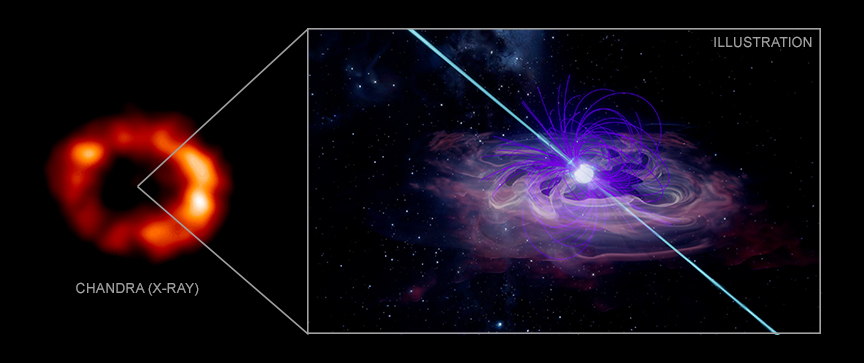Since astronomers captured the bright explosion of a star on February 24, 1987, they have been searching for the squashed stellar core that should have been left behind. A new study from two NASA X-ray telescopes may have finally been successful.

As the first supernova visible with the naked eye in the last four hundred years, Supernova 1987A, or SN 1987A for short, caused great excitement among scientists and soon became one of the most studied objects in the sky. The supernova is located in the Large Magellanic Cloud, a small companion galaxy to our own only about 170,000 light years from Earth. A supernova is a powerful and luminous stellar explosion. This transient astronomical event occurs during the last evolutionary stages of a massive star or when a white dwarf is triggered into runaway nuclear fusion. The original object, called the progenitor, either collapses to a neutron star or black hole, or is completely destroyed. The peak optical luminosity of a supernova can be comparable to that of an entire galaxy before fading over several weeks or months.
While astronomers watched debris explode outward from the site of the detonation, they also looked for what should have remained of the star’s core: a neutron star.

In this latest result, astronomers combined X-ray data from NASA’s Chandra X-ray Observatory and the Nuclear Spectroscopic Telescope Array, or NuSTAR, along with radio data from the Atacama Large Millimeter Array reported last year. Taken all together, this team presented an intriguing collection of evidence for the presence of a neutron star at the center of SN 1987A.
When a star explodes, it collapses onto itself before the outer layers are blasted into space. The compression of the core turns it into an extraordinarily dense object, with the mass of the Sun squeezed into an object only about 10 miles across. These objects have been dubbed neutron stars, because they are made nearly exclusively of densely packed neutrons. They are laboratories of extreme physics that cannot be duplicated here on Earth.

Rapidly rotating and highly magnetized neutron stars — called pulsars — produce a lighthouse-like beam of radiation that astronomers detect as pulses when its rotation sweeps the beam across the sky. Some pulsars produce winds from their surfaces – sometimes at nearly the speed of light – that create intricate structures of charged particles and magnetic fields known as “pulsar wind nebulas.”
The latest X-ray study supports the case for a pulsar wind nebula and argues against another scenario involving accelerating particles from the blast wave. Additional research will be needed to confirm the results from this latest promising study. Astronomers will continue to observe and examine SN 1987A in the coming years to see what this fascinating object reveals next.
